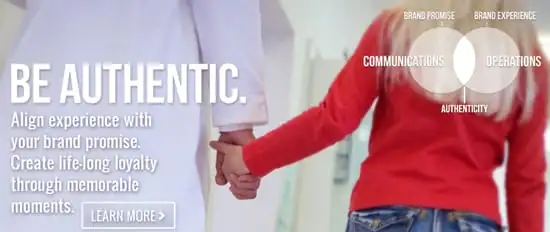As any successful healthcare marketer can attest, advertising alone does not build emotional connections with healthcare consumers. Patients need to personally experience “compassionate, personalized care” when they interact with your brand, or what you’re promoting simply isn’t true.
To connect emotionally in ways that build affinity and loyalty, make it authentic by carrying that connection through the entire patient experience. Research shows the difference between having ‘emotionally connected’ customers, as opposed to those who are just ‘highly satisfied,’ can be measured in dollars and cents. Through those measurements, we see emotional connections create more valuable customers. For the skeptics out there, consider this:
A recent article, called Making Better Marketing Decisions: A Left-Brain Argument for the Right Brain, examines the potential for emotional drivers to increase profitability in major consumer industries. The author cites an example from the banking sector, in which scientific research and mathematical modeling were used to reach an accurate understanding of the specific attributes that drive purchase and loyalty behaviors. For banks, the data showed that, compared to highly satisfied customers, “emotionally connected customers own more banking products, carry higher credit card balances and advocate for their bank’s brand more often.” As a result, data further suggest an estimated $14.2 million boost in net present value profit is on the table when the number of emotionally connected customers grows from one to five percent.
Granted, banking is different from healthcare, but the overarching lesson is the same: healthcare marketers need to tap into emotions and right-brain functions in their marketing and branding strategies. For an off-the-cuff case study in what emotional branding can look like in healthcare, let’s briefly explore what they’re doing at the Cleveland Clinic health system:
With an executive team that includes a Chief Experience Officer and strategic priorities aimed at improving the patient experience, the Cleveland Clinic has made great strides since 2009 at connecting emotionally with consumers. After taking a deep, data-driven dive into the hearts and minds of their consumers, leadership began making operational changes to enhance the experience they deliver. Non-clinical touch points like patient scheduling, facility aesthetics and an emphasis on addressing patient fears and concerns have all been improved. They also adopted a new clinical model that has multidisciplinary specialists collaborating seamlessly on patient care, which enhances the patient experience on multiple levels from convenience to well-coordinated care.
In other words, the Cleveland Clinic’s patient experience now extends far beyond the medical outcomes it has long been known for, and into other areas where the experience feels less about clinicians treating patients and more about people helping people.
With its reputation for looking after patients’ physical AND emotional well-being, the Cleveland Clinic can now authentically convey its ability to treat patients as individuals with unique concerns, lifestyles and circumstances. If the Clinic distributed this widely viewed “Empathy: The Human Connection to Patient Care” video four years ago, however, the message would’ve fallen flat because the patient experience in 2009 did not reflect the genuine understanding and compassion so eloquently depicted in the video. Now, with an elevated patient experience to back it up, the message is resonating well with people, as evidenced by the video’s nearly 100,000 views on YouTube and countless shares on other social sites.
If you’re not already taking strategic steps to create emotionally connected customers, you can’t afford to wait. The concept is taking hold within the healthcare industry, so build personalized, meaningful bonds with your patients now before your competition beats you to it. Because once an emotional bond is made, it’s hard to persuade that customer to try another brand…and that’s the whole point.

